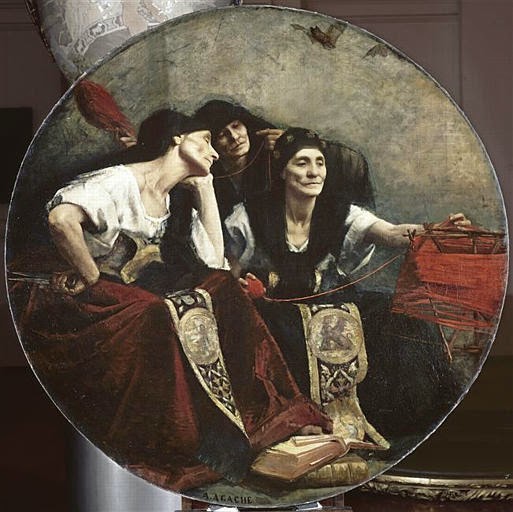What is the Greek for Atropos' abhorréd shears?
~in collaboration with Robert Alspaugh (https://ralspaugh.wordpress.com/?ref=spelling)
While doing an illustration of the Moirai for a genealogical mural in my classroom, I wondered, "what is the Greek for Atropos' abhorréd shears by which she cuts the thread of life and ends a mortal's worldly existence?" |
| Bitchin'. |
Answer: What's ancient Greek for 404 Error? Tettera-Ouden-Tettera?
There is no Greek for the abhorréd shears. The first reference to the shears appears in Milton.
But the fair Guerdon when we hope to find,
And think to burst out into sudden blaze,
Comes the blind Fury with th' abhorred shears, [ 75 ]
And slits the thin spun life. But not the praise,
Phœbus repli'd, and touch'd my trembling ears;
-Milton, Lycidas
Huh...well...then what does Atropos do? Isn't she defined by her shears? Klotho weaves the thread, Lakhesis measures it, and Atropos, "The Unturnable", cuts it... right?
It seems not.
A few hours, several books, and internet sites later, the following was crystallized:
Greek: Μοῖραι - "The Apportioners";
Italic: Parcae - "The Twine-ers" (cf. Grk: πλέκω -"to twine");
 |
| Les Parques, Alfred Agache, c. 1885 |
Germanic: Nornir - The Norns - "The Witches"
Slavic: Sudice
Appearing as a tripartite goddess, the three were depicted as spinners or weavers; though as their function and appearance changes with each author, they originally were never thought of as "cutters".
In the Hellenic branch, the three and their jobs and iconography were originally categorized as such:
Κλωθώ - Klôthô - "The Spinner" - she spins the thread of life, handing the carded wool to her sister Lakhesis. She is usually depicted with a ball of wool. Her name is etymologically related to the Old English clath, "a woven thing".
In Italic mythology she appears as Nona, "The Ninth", in which she visits an expectant mother in the ninth month of her pregnancy to begin spinning the thread of the child's life.
For the Northmen, she was Urðr, cognate with the Old English Wyrd. She is concerned with the Past (urðr means "that which has happened").
For the Eastern Europeans, she was one of three old women who appears before an infant in its cradle after birth. She had a fattened lower lip from continuously salivating on the thread of life.
Λάχεσις - Lakhesis: "The Alloter" - she takes the carded wool from Klôthô and wraps it around the distaff. The spinning process causes the wool to bind together into a thread. The Greek lakhos, "a lot, portion, fate" refers to being awarded a portion of something, in this case, the length of the thread, the length of life.
In Italic mythology she appears as Decuma/Decima, "The Tenth", in which month since conception the child's life is allotted.
For the Northmen, she was Verðandi, and was concerned with the Present (verða means "that which is happening").
For the Eastern Europeans, she appeared at the cradle of an infant with her sisters. She had a fattened thumb from continuously fingering the flax to make the thread of life.
Ἄτροπος - Atropos, "The Unwraveler"- though her name has almost always been interpreted as the alpha privative a- "un-" and tropos, "a turning"- "the Unturnable One" referring to her supposedly immovable nature in severing the thread of life, I propose a different meaning: the alpha privative a- "un-" and tropos, "the thing turned, 'wraveled', or wrapped", in reference to wrapping a leather strap about an oar. Atropos refers to unwrapping that strap. So for the Greeks, all Atropos does is take the thread off of the distaff. She sets it aside, where it will be taken by Death and severed at the moment of life's end (by means of either his teeth or a blade of some kind).
In Italic mythology she appears as Morta, "Death", in which she does cut the thread of life with a knife, sword, or her teeth.
For the Northmen, she was Skuld, and was concerned with the Future (skulla means "that which shall be").
For the Eastern Europeans, she appeared at the cradle of an infant with her sisters. She had an enlarged left foot from continuously working the pedal of the spinning wheel, spinning the thread of life - curiously enough, this version caught up with technology, as there a spinning wheel in it, an invention introduced to Europe as early as the 13th century A.D. -the Homeric Moirai stretch back to the 8th century B.C.
One can see the confusion. From the Hellenic, Italic, and Germanic branches we are presented with an amalgamation of a tripartite godhead whose triple aspects weave the thread of a mortal's life, while also seeing into the Past, Present, and Future simultaneously, and having the power over Death by cutting the thread.
Don't get me started on Disney:
 |
| Wait, now they're the Graiai? |





No comments:
Post a Comment